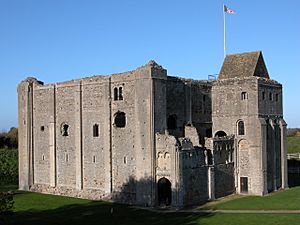Isabella of France facts for kids
Quick facts for kids Isabella of France |
|
|---|---|
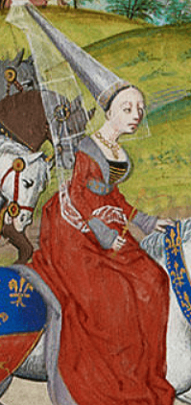
15th-century depiction
from Froissart's Chronicles |
|
| Queen consort of England | |
| Tenure | 25 January 1308 – 25 January 1327 |
| Coronation | 25 February 1308 |
| Born | c. 1295 Paris, France |
| Died | 22 August 1358 (aged 62–63) Hertford Castle, England |
| Burial | 27 November 1358 Grey Friars' Church at Newgate |
| Spouse | |
| Issue | |
| House | Capet |
| Father | Philip IV of France |
| Mother | Joan I of Navarre |
Isabella of France (born around 1295 – died August 22, 1358) was the Queen of England. She was married to King Edward II. From 1327 to 1330, she served as the regent of England, meaning she ruled the country on behalf of her young son.
Isabella was the youngest surviving child and only daughter of Philip IV of France and Joan I of Navarre. During her lifetime, she was known for her diplomatic skills, intelligence, and beauty. She played a key role in removing her husband from power. Later, she was sometimes called the "She-Wolf of France."
Isabella came to England when she was about 12 years old. At this time, there was growing conflict between King Edward II and powerful noble groups called barons. Her husband, Edward, was known for favoring his friend, Piers Gaveston. Isabella supported Edward in the early years and even worked with Piers. She used her connections to the French royal family to increase her own influence.
After Gaveston was killed by the barons in 1312, Edward found a new favorite, Hugh Despenser the Younger. Edward then tried to get revenge on the barons, which led to a period of harsh rule across England. Isabella strongly disliked Hugh Despenser. By 1325, her marriage to Edward was in serious trouble.
Isabella traveled to France for a diplomatic mission. There, she formed an alliance with Roger Mortimer. They likely decided to remove Edward and the Despenser family from power. In 1326, Queen Isabella returned to England with a small army. The King's forces abandoned him. Isabella removed Edward from the throne and became regent for her young son, Edward III. Some people believe Isabella then arranged for Edward II to be killed.
Isabella and Mortimer's rule began to weaken. This was partly due to her expensive spending. However, she also successfully ended the long-running war with Scotland, which was unpopular with some nobles. In 1330, when he was 18, Edward III took control. Mortimer was executed, Isabella's regency ended, and she was held captive for a time. After two years, she was released and lived a comfortable life. She often visited court to see her grandchildren, but she no longer took part in politics.
Contents
Early Life and Royal Marriage: 1295–1308
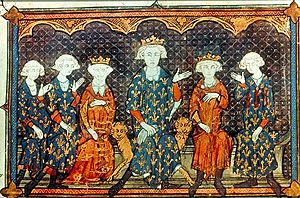
Isabella was born in Paris, France. Her exact birth date is not known, but it was likely between April 1295 and January 1296. Chroniclers at the time said she was 12 years old when she married in January 1308. This also suggests her birth was around 1295 or 1296.
Her parents were King Philip IV of France and Queen Joan I of Navarre. Her brothers, Louis, Philip, and Charles, all became kings of France. Isabella grew up in a powerful royal family that ruled one of the strongest countries in Western Europe.
Her father, King Philip, was known as "the Fair" because he was handsome. He was a very serious and unemotional man. Philip made the royal government in France more powerful. He also fought many wars to expand French control. He was always trying to gain more wealth and land, a trait his daughter Isabella was also accused of later in life. Isabella's mother died when Isabella was young.
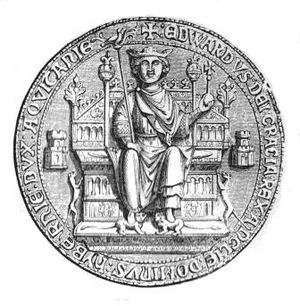
Isabella was raised in palaces in Paris, like the Louvre Palace. She had a good education and learned to read. She loved books. It was common for royal children to marry young for political reasons. Isabella was promised to Edward, the son of King Edward I of England. This marriage was meant to help solve conflicts between France and England. These conflicts were mostly about England's lands in France, such as Gascony.
The marriage was delayed several times. King Edward I of England even tried to break off the engagement for political reasons. The wedding finally happened after Edward I died in 1307.
Isabella and Edward II were married in Boulogne-sur-Mer, France, on January 25, 1308. Isabella's wedding clothes and belongings showed her wealth. She had many beautiful dresses, furs, and headdresses. She also brought gold and silver dinnerware. At the time of her marriage, Isabella was about 12 years old. She was described as "the beauty of beauties" in Europe. She was said to look like her handsome father. Isabella was known for being charming and good at diplomacy. People also noted her high intelligence, which was unusual for women in that time.
Isabella's Time as Queen
As queen, young Isabella faced many challenges. Edward was handsome but very unusual for a king. He seemed to prefer close male friends, first Piers Gaveston and then Hugh Despenser the Younger. Edward also disagreed with powerful nobles, especially his cousin Thomas, 2nd Earl of Lancaster. He also continued the war against Scotland that his father had started.
Isabella used her own supporters at court and her French family's help to navigate these challenges. She managed to work with Gaveston for a while. But after Gaveston's death, her position became more difficult. Edward began to get revenge on his enemies. He formed a harsh alliance with the Despenser family, especially his new favorite, Hugh Despenser the Younger. By 1326, Isabella was strongly against both Edward and Hugh. This eventually led to Isabella's own plan to take power and invade England.
Gaveston's Fall: 1308–1312
Edward was a very different kind of king for his time. He looked like a perfect Plantagenet king, being tall and athletic. He was very popular when he first became king. However, he did not enjoy traditional royal activities like jousting or warfare. Instead, he liked music, poetry, and crafts. Isabella and Edward had four children together.
Isabella's relationship with Gaveston was complicated. For a time, she clearly disliked him. She even tried to get her father and the Pope to have him sent away. Many nobles, led by Thomas of Lancaster, also opposed Gaveston. Isabella's father, Philip IV, secretly supported these nobles. Edward was forced to send Gaveston away to Ireland. After this, Edward began to treat Isabella with more respect. He gave her lands and support. In return, Philip stopped helping the nobles.
Gaveston eventually returned from Ireland. From 1309 to 1311, the three of them seemed to get along. In fact, Gaveston's main enemy, Thomas of Lancaster, thought Isabella was Gaveston's ally. Isabella had started to build her own group of supporters at court. This group was mainly the Beaumont family, who were also against the Lancastrians.
In 1311, Edward's campaign against the Scots failed. Isabella and Edward barely escaped being captured. After this, the barons rose up. They signed the Ordinances of 1311, which demanded action against Gaveston. Isabella and her supporter Henry de Beaumont were also expelled from court. In 1312, a civil war began against the king. Isabella supported Edward. She sent angry letters to her uncles in France asking for help. Edward left Isabella at Tynemouth Priory while he fought the barons. The campaign was a disaster. Edward escaped, but Gaveston was captured. His enemies, Guy de Beauchamp and Thomas of Lancaster, had him executed.
Growing Problems: 1312–1321
Problems steadily increased over the next ten years. In 1312, Isabella gave birth to her first son, the future Edward III. But by the end of that year, Edward's court began to change. Edward still relied on his French relatives for help. However, Hugh Despenser the Elder became part of his inner circle. This marked the start of the Despenser family's growing power at Edward's court.
The Despensers were strong enemies of Lancaster. They easily formed an alliance with Edward, who wanted revenge for Gaveston's death. In 1313, Isabella traveled to Paris with Edward to get more French support. The trip was pleasant, with many celebrations. During the visit, Isabella's brothers put on a puppet show. Isabella had given new embroidered purses to her brothers and their wives. Later, Isabella noticed that two Norman knights were carrying the purses she had given to her sisters-in-law. This led to the Tour de Nesle Affair in Paris. Isabella's three sisters-in-law faced legal action. Two were imprisoned for life, and one for a year.
In the north, the situation got worse. Edward tried to defeat the Scots in 1314. This led to a terrible defeat at the Battle of Bannockburn. The barons blamed Edward for the failure. Thomas of Lancaster gained more power in England. He turned against Isabella, cutting off her money and bothering her household. To make things worse, the "Great Famine" hit England from 1315 to 1317. This caused many deaths and financial problems.
Despite Isabella giving birth to her second son, John, in 1316, Edward's position was unstable. A man named John Deydras claimed to be the real king. He said he had been switched with Edward at birth. Because Edward was unpopular, these rumors spread widely. Isabella was very upset by them. She responded by strengthening her alliance with Henry de Beaumont, Lancaster's enemy. She also took on a bigger role in government herself. She attended council meetings and gained more land. In 1319, a Scottish general, Sir James Douglas, tried to capture Isabella near York. Isabella barely escaped.
Meanwhile, Hugh Despenser the Younger became Edward's new favorite. Hugh was the same age as Edward. His father, Hugh the Elder, had supported Edward before. The Despensers were bitter enemies of Lancaster. With Edward's help, they began to gain more power in Wales. This made enemies of Roger Mortimer de Chirk and his nephew, Roger Mortimer of Wigmore. Isabella had been able to work with Gaveston, but it was clear she could not work with Hugh the Younger. In 1321, Lancaster's allies moved against the Despensers. They sent troops into London and demanded the Despensers be sent away. Isabella publicly begged Edward to exile the Despensers. This gave him an excuse to do so, but Edward planned to bring them back as soon as possible.
Despensers Return, 1321–1326
Even though Isabella had brought a short peace, by autumn 1321, tensions were very high. Edward, Isabella, and the Despensers were against the nobles led by Thomas of Lancaster. Armies were ready across the country. At this point, Isabella went on a pilgrimage to Canterbury. She stopped at Leeds Castle in Kent. This castle was held by Bartholomew de Badlesmere, who was now against Edward. Some historians believe Isabella's stop was a planned act to start a conflict. Lord Badlesmere was away, and his wife, Margaret de Clare, Baroness Badlesmere, was in charge. She refused to let the Queen in. Fighting broke out between Isabella's guards and the castle's soldiers. This marked the start of the Despenser War.
Edward gathered his forces and besieged Leeds Castle. Isabella was given the Great Seal and took control of the royal government from the Tower of London. After the castle surrendered, Margaret and her children were sent to the Tower. Thirteen of the castle's soldiers were executed. By January 1322, Edward's army, with the Despensers back from exile, forced the Mortimers to surrender. By March, Lancaster himself was captured after the Battle of Boroughbridge. Lancaster was quickly executed. Edward and the Despensers were now victorious.
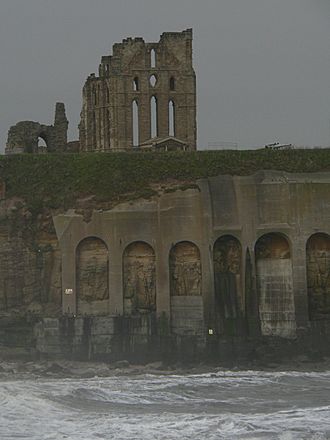
Hugh Despenser the Younger was now Edward's main favorite. For the next four years, Edward and the Despensers ruled England very harshly. They took lands, imprisoned many people, and carried out executions. Even women and the elderly in families connected to their enemies were punished. People at the time criticized this. Isabella was also concerned, as some of the widows being punished were her friends.
Isabella's relationship with Despenser the Younger got worse. The Despensers refused to pay her money she was owed. They also would not return her castles. Some writers suggest that Hugh Despenser the Younger treated Isabella very badly. After the Battle of Boroughbridge, Edward gave Isabella fewer gifts. She received none of the spoils from the war.
Even worse, later that year, Isabella was caught in another failed campaign by Edward in Scotland. This event completely ruined her relationship with both Edward and the Despensers. Isabella and Edward had traveled north together. Before the terrible Battle of Old Byland in Yorkshire, Edward rode south to get more soldiers. He sent Isabella east to Tynemouth Priory. The Scottish army was marching south. Isabella was very worried about her safety and asked Edward for help. Edward first suggested sending Despenser's soldiers, but Isabella refused. She asked for friendly troops.
Edward quickly retreated south with the Despensers. He did not understand how dangerous Isabella's situation was. Isabella and her household were cut off from the south by the Scottish army. The coast was patrolled by ships allied to the Scots. The situation was very risky. Isabella had to use her personal guards to hold off the advancing army. Other knights took control of a ship. Fighting continued as Isabella and her household got onto the ship. Two of her ladies-in-waiting died. Once on board, Isabella escaped the enemy ships. She landed further south and made her way to York. Isabella was furious with Edward for abandoning her. She was also angry with the Despensers for convincing Edward to retreat instead of sending help.
From this point on, Isabella largely separated from Edward. She left him to live with Hugh Despenser. At the end of 1322, Isabella went on a ten-month pilgrimage around England by herself. When she returned in 1323, she visited Edward briefly. However, she was no longer allowed to grant royal favors. At the end of 1324, tensions grew with France, Isabella's home country. Edward and the Despensers took all of Isabella's lands. They took control of her household and arrested all her French staff. Isabella's youngest children were taken from her and placed with the Despensers. At this point, Isabella realized that working with Edward was impossible. She began to think about drastic solutions.
Invading England
By 1325, Isabella was under great pressure from Hugh Despenser the Younger. Her lands in England were taken, her children were removed, and her staff were arrested. Isabella started to look for other ways to solve her problems. When her brother, King Charles IV of France, took Edward's French lands in 1325, Isabella went to France. She first went as a representative of the King to negotiate a peace treaty.
However, her presence in France became a rallying point for many nobles who opposed Edward's rule. Isabella gathered an army to fight Edward. She allied with Roger Mortimer, 1st Earl of March. Isabella and Mortimer returned to England with an army of hired soldiers. They quickly took control of the country. The Despensers were executed. Edward was forced to give up his throne. What happened to Edward after that, and whether he was murdered, is still debated by historians. Isabella ruled as regent until 1330. Then, her son, Edward, removed Mortimer from power and began to rule on his own.
Problems in Gascony, 1323–1325
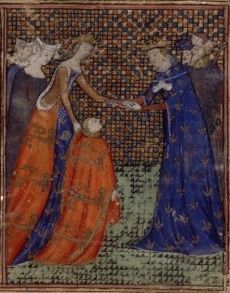
Isabella's husband, Edward, was the Duke of Aquitaine. This meant he had to show loyalty, called homage, to the King of France for his lands in Gascony. Isabella's three brothers each ruled for only a short time. Edward had avoided paying homage to Louis X and only paid homage to Philip V under great pressure. When Charles IV became king, Edward tried to avoid paying homage again. This increased tensions between the two countries.
One of the issues was the border area of Agenais, part of Gascony. In November 1323, tensions rose after a French noble built a fortified town in Saint-Sardos. Gascon forces destroyed the town. In response, Charles attacked the English-held Montpezat. The attack failed, but in the following War of Saint-Sardos, Isabella's uncle, Charles of Valois, successfully took Aquitaine from English control. By 1324, Charles had declared Edward's lands lost and occupied almost all of Aquitaine.
Edward still did not want to travel to France to pay homage. The situation in England was unstable. There had been a plot to kill Edward and Hugh Despenser in 1324. Criminal gangs were also causing problems across the country. Edward was worried that if he left England, the nobles would rise up against the Despensers. Charles sent a message through Pope John XXII to Edward. He suggested he would return the lands if Edward gave up Agenais and paid homage for the rest. The Pope suggested Isabella as an ambassador. Isabella saw this as a perfect chance to improve her situation with Edward and the Despensers.
Isabella promised to return to England by summer. She arrived in Paris in March 1325. She quickly agreed to a truce in Gascony. As part of the agreement, Prince Edward, who was 13, would come to France to pay homage for his father. Prince Edward arrived in France and paid homage in September. However, Isabella did not return to England. She stayed in France with her son.
Edward began sending urgent messages to the Pope and Charles IV. He was worried about his wife's absence, but it did no good. Edward ordered Isabella to come home in September. But she said she feared Hugh Despenser or even her husband might try to kill her. Charles replied that Isabella "has come of her own will and may freely return if she wishes. But if she prefers to remain here, she is my sister and I refuse to expel her." Charles also refused to return the lands in Aquitaine to Edward.
Meanwhile, reports from Edward's agents grew worse. Isabella had publicly ignored Edward's representative. Edward's political enemies were gathering at the French court. Isabella was dressed as a widow, claiming Hugh Despenser had ruined her marriage. She was gathering a group of exiled nobles, including Edmund of Kent. Isabella surrounded herself with these exiles, including Roger Mortimer.
Roger Mortimer, 1325–1326

Roger Mortimer was a powerful noble. He had been imprisoned in the Tower of London in 1322 after Edward captured him. Mortimer's uncle died in prison, but Mortimer managed to escape the Tower in August 1323. He made a hole in his cell wall and escaped to the River Thames. He then made his way to safety in France. Some historians believe Isabella might have helped Mortimer escape. Most historians, however, believe their close relationship began after they met in Paris.
Isabella was reintroduced to Mortimer in Paris by her cousin, Joan, Countess of Hainault. Joan suggested a marriage alliance between their families. She proposed marrying Prince Edward to Joan's daughter, Philippa. Mortimer and Isabella may have started their close relationship from December 1325 onwards.
Isabella and Mortimer left the French court in summer 1326, taking Prince Edward with them. They traveled north to William I, Count of Hainaut. As Joan had suggested, Isabella arranged for Prince Edward to marry Philippa of Hainault. In return, she received a large sum of money. She used this money, plus an earlier loan from Charles, to raise an army of hired soldiers. William also provided ships for the invasion. Edward was now worried about an invasion. Isabella convinced William to hold back Edward's messengers. Isabella also made a secret agreement with the Scots for the upcoming campaign. On September 22, Isabella, Mortimer, and their forces sailed for England.
Taking Power, 1326

Isabella and Mortimer avoided Edward's fleet. They landed at Orwell on the east coast of England on September 24. Their army was small, estimated between 300 and 2,000 soldiers. After a short time, Isabella moved quickly inland, dressed in her widow's clothes. The local soldiers sent to stop them immediately joined Isabella's side. By the next day, Isabella was in Bury St Edmunds. Soon after, she reached Cambridge. Thomas, Earl of Norfolk, joined Isabella's forces. Henry of Lancaster – the brother of the late Thomas – also joined Isabella.
By September 27, news of the invasion reached the King and the Despensers in London. Edward ordered local officials to gather opposition to Isabella and Mortimer. But London itself was becoming unsafe due to local unrest. Edward planned to leave. Isabella moved west again, reaching Oxford on October 2. She was "greeted as a saviour." Adam Orleton, the Bishop of Hereford, gave a speech against the Despensers at the university. Edward fled London the same day, heading west towards Wales. Isabella and Mortimer now had a strong alliance with all of Edward's opponents.
Isabella then marched south towards London. She paused at Dunstable on October 7. London was now controlled by angry crowds, who mostly supported Isabella. Bishop Stapledon did not realize how much royal power had collapsed. He tried to use soldiers to protect his property. He was hated locally and was quickly attacked and killed. Edward, meanwhile, was still fleeing west, reaching Gloucester by October 9. Isabella responded by quickly marching west herself to cut him off. She reached Gloucester a week after Edward, who slipped across the border into Wales that same day.
Hugh Despenser the Elder still held Bristol against Isabella and Mortimer. They besieged it from October 18–26. When it fell, Isabella was able to get back her daughters, Eleanor and Joan. They had been held by the Despensers. By now, Edward and Hugh Despenser the Younger were desperate. Their court was leaving them. They tried to sail to Lundy, a small island, but bad weather forced them back to Wales. With Bristol secure, Isabella moved her base to Hereford. From there, she ordered Henry of Lancaster to find and arrest her husband. After two weeks of avoiding Isabella's forces in South Wales, Edward and Hugh were finally caught near Llantrisant on November 16.
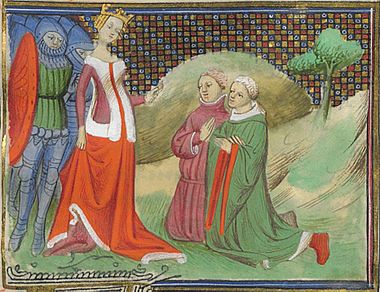
Punishment began immediately. Hugh Despenser the Elder was captured at Bristol. Isabella tried to protect him, but he was quickly executed by his enemies. The rest of the former government were brought to Isabella. Edmund Fitzalan, a key supporter of Edward II, was executed on November 17. Hugh Despenser the Younger was sentenced to be executed on November 24. A huge crowd gathered to watch him die. Simon of Reading, one of the Despensers' supporters, was executed next to him for insulting Isabella. Once the main Despenser supporters were executed, Isabella and Mortimer showed some restraint. Lesser nobles were pardoned. Government officials, mostly appointed by the Despensers, kept their jobs. All that remained was the question of Edward II, who was still officially Isabella's husband and the lawful king.
Edward's Death, 1327
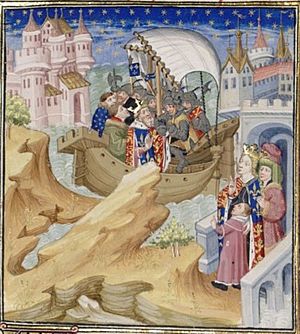
For a time, Edward II was held by Henry of Lancaster. Lancaster gave Edward's Great Seal to Isabella. The situation was still tense. Isabella was worried about Edward's supporters trying to take back power. In November, she took the Tower of London. She appointed one of her supporters as mayor. She called a meeting of nobles and churchmen in Wallingford to decide Edward's fate. The group decided that Edward would be officially removed from power. He would be held under house arrest for the rest of his life.
This decision was confirmed at the next parliament, which was controlled by Isabella and Mortimer's followers. The meeting was held in January 1327. Isabella's supporter, Adam Orleton, led her case. Isabella's son, Prince Edward, was confirmed as Edward III of England. His mother, Isabella, was appointed regent. Isabella's position was still uncertain. The legal reasons for removing Edward were weak. Many lawyers believed Edward II was still the rightful king. The situation could change at any moment, and Edward II was known to be vengeful.
What happened to Edward II after this, and Isabella's role, is still debated by historians. The basic story is that Isabella and Mortimer moved Edward from Kenilworth Castle to the safer Berkeley Castle. There, he was placed under the care of Lord Berkeley. On September 23, Isabella and Edward III were told by messenger that Edward had died in prison due to a "fatal accident." Edward's body was reportedly buried at Gloucester Cathedral. His heart was given to Isabella in a casket. After the funeral, rumors spread for many years that Edward had survived and was alive somewhere in Europe. However, no clear proof ever appeared to support these claims.
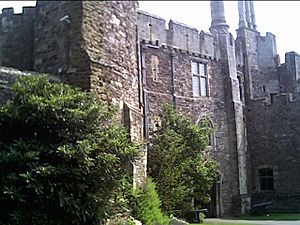
According to some stories, Isabella and Mortimer planned to murder Edward in a way that would not blame them. They supposedly sent a famous message that could be read two ways: "Do not be afraid to kill Edward; it is good" or "Do not kill Edward; it is good to fear." In reality, there is little proof that anyone decided to kill Edward, and no proof that such a note was ever written. The common view in the 20th century was that Edward did die at Berkeley Castle. This was either by murder on Isabella's orders or from illness due to his captivity. Stories of his survival were just rumors.
However, some recent historians have offered different ideas. They suggest that Edward might have escaped from Berkeley Castle. In these ideas, a look-alike was buried at Gloucester. Or, Roger Mortimer might have planned a fake escape for Edward. In these versions, it suited Isabella and Mortimer to publicly claim Edward was dead, even if they knew the truth. Other historians, however, disagree with these newer ideas.
Later Years
Isabella and Mortimer ruled together for four years. During Isabella's time as regent, she gained huge amounts of money and land. When her political alliance with the Lancastrians began to fall apart, Isabella continued to support Mortimer. Isabella lost power when her son, Edward III, removed Mortimer in a sudden takeover. Edward III then took back royal authority for himself. Unlike Mortimer, Isabella survived this change of power. She remained a wealthy and important person at the English court. However, she never returned directly to active politics.
As Regent, 1326–1330
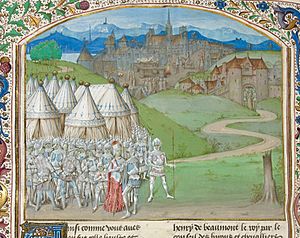
Isabella's regency lasted only four years. The fragile political alliance that brought her and Mortimer to power soon broke apart. In 1328, Isabella's son, Edward III, married Philippa of Hainault. This was agreed before the invasion of 1326. The grand ceremony was held in London and was very popular. Isabella and Mortimer had already started to gather huge wealth. Isabella was already very rich after her lands were returned to her. But she began to get even more.
Within the first few weeks, Isabella gave herself almost £12,000. She found that Edward's royal treasury had £60,000. A period of quick spending then began. Isabella soon gave herself another £20,000, supposedly to pay off foreign debts. At Edward III's coronation, Isabella increased her land holdings. Their value went from £4,400 each year to a huge £13,333. This made her one of the largest landowners in the kingdom. Isabella also refused to give her dower lands to Philippa after her marriage to Edward III. This was against the usual custom. Isabella's expensive lifestyle matched her new income. Mortimer, who was like her chief minister, also began to gain lands and titles very quickly.
The new government also faced important foreign policy problems. Isabella dealt with these in a practical way. The first problem was Scotland. Edward II's failed policies had left an unfinished and very expensive war. Isabella wanted to end this issue through diplomacy. Edward III at first disagreed with this plan. But he eventually gave in. This led to the Treaty of Northampton. Under this treaty, Isabella's daughter Joan would marry David Bruce, who was the heir to the Scottish throne. Edward III would give up any claims to Scottish lands. In return, Scotland promised military help against any enemy except the French. They also paid £20,000 in compensation for raids in northern England. No money was given to the nobles who had lost their Scottish lands. Isabella took the compensation money. Although this policy was successful in the long run, it was not popular. It added to the general unhappiness with the government.
Secondly, the Gascony situation, which was still unresolved from Edward II's reign, was also a problem. Isabella reopened talks in Paris. This resulted in a peace treaty. Most of Gascony, except for the Agenais, would be returned to England. In exchange, England would pay a 50,000-mark penalty. The treaty was not popular in England because of the Agenais clause.
Henry, Earl of Lancaster, was one of the first to break with Isabella and Mortimer. By 1327, Lancaster was annoyed by Mortimer's actions. Isabella responded by slowly removing him from her government. Lancaster was furious about the Treaty of Northampton. He refused to attend court and gathered support among the common people of London. Isabella responded by making wide reforms to the royal government and local law enforcement. In a move to gain public support, Isabella also decided to pursue Edward III's claim to the French throne. She sent her advisers to France to demand official recognition of his claim. The French nobles were not impressed. Since Isabella did not have enough money for a military campaign, she began to seek support from France's neighbors.
By the end of 1328, the situation was almost civil war again. Lancaster gathered his army against Isabella and Mortimer. In January 1329, Isabella's forces, led by Mortimer, took Lancaster's stronghold of Leicester. Then they took Bedford. Isabella – wearing armor and riding a warhorse – and Edward III marched quickly north. This resulted in Lancaster's surrender. He avoided death but had to pay a huge fine, which greatly reduced his power. Isabella was kind to those who had sided with him. However, some, like her old supporter Henry de Beaumont, fled to France. His family had split from Isabella over the peace with Scotland, which had cost them huge land holdings.
Despite Lancaster's defeat, unhappiness continued to grow. Edmund of Kent had supported Isabella in 1326. But he began to question his decision and was leaning back towards Edward II, his half-brother. Edmund of Kent talked with other important nobles who questioned Isabella's rule. These included Henry de Beaumont and Isabella de Vesci. Edmund was finally involved in a plot in 1330. He claimed it was to bring back Edward II, who he said was still alive. Isabella and Mortimer stopped the plot. They arrested Edmund and other supporters. Edmund might have expected a pardon, possibly from Edward III. But Isabella insisted on his execution. The execution itself was a mess. The executioner refused to do it. Edmund of Kent had to be killed by a local dung-collector, who was promised a pardon as a bribe. Isabella de Vesci escaped punishment, even though she was closely involved in the plot.
Mortimer's Fall from Power, 1330
By mid-1330, Isabella and Mortimer's government was becoming very unstable. Isabella's son, Edward III, was growing frustrated with Mortimer's control over power. Some historians also suggest that Isabella became pregnant in late 1329. A child of Mortimer's with royal blood would have been politically difficult for Isabella and a challenge to Edward's own position.
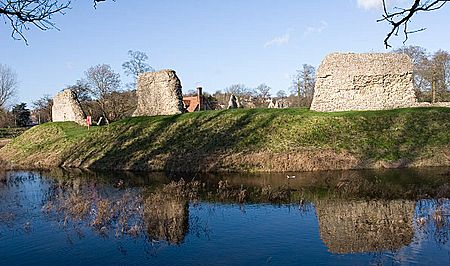
Edward quietly gathered support from the Church and selected nobles. Isabella and Mortimer moved into Nottingham Castle for safety. They surrounded themselves with loyal soldiers. In the autumn, Mortimer was investigating another plot against him. He challenged a young noble, William Montagu, during questioning. Mortimer declared that his word was more important than the king's. This was a shocking statement that Montagu reported to Edward. Edward was convinced this was the moment to act. On October 19, Montagu led 23 armed men into the castle through a secret tunnel.
Up in the keep, Isabella, Mortimer, and other council members were discussing how to arrest Montagu. Then Montagu and his men appeared. Fighting broke out on the stairs, and Mortimer was captured in his room. Isabella famously pleaded with Edward, crying "Fair son, have pity on gentle Mortimer!" Soldiers loyal to Lancaster quickly took the rest of the castle. Edward was now in control of his own government for the first time.
Parliament met the next month. Mortimer was put on trial for treason. Isabella was presented as an innocent bystander during the trial. Mortimer was executed at Tyburn.
In Retirement, 1330–1358
After the takeover, Isabella was first moved to Berkhamsted Castle. Then she was held under house arrest at Windsor Castle until 1332. After that, she moved back to her own Castle Rising in Norfolk. One historian from the Victorian era suggested Isabella had occasional fits of madness during this time. But modern historians believe it was, at worst, a nervous breakdown after Mortimer's death.
Isabella remained very wealthy. Even though she had to give up most of her lands after losing power, in 1331 she was given a yearly income of £3000. This increased to £4000 by 1337. She lived an expensive lifestyle in Norfolk. She had musicians, hunters, and other luxuries. She soon began traveling around England again. In 1348, there were talks that she might go to Paris for peace negotiations, but this plan was eventually stopped. She was involved in talks with Charles II of Navarre in 1358.
As she got older, Isabella became very close to her daughter Joan. Especially after Joan left her husband, King David II of Scotland. Joan nursed her just before she died. Isabella loved her grandchildren, including Edward, the Black Prince. She became more interested in religion as she aged, visiting many holy places. However, she remained a social person at court. She received constant visitors, including her friend Marie de St Pol, Countess of Pembroke, and her cousin Henry of Grosmont, Duke of Lancaster. King Edward and his children often visited her too.
She remained interested in Arthurian legends and jewelry. In 1358, she appeared at the St George's Day celebrations at Windsor. She wore a dress made of silk, silver, 300 rubies, 1800 pearls, and a gold circlet. She may have developed an interest in astrology or geometry towards the end of her life.
Isabella became a nun of the Poor Clares before she died on August 22, 1358, at Hertford Castle. Her body was brought back to London for burial at the Franciscan church at Newgate. The service was led by Archbishop Simon Islip. She was buried in the cloak she wore at her wedding. At her request, Edward's heart, which had been placed in a casket 30 years before, was buried with her. Isabella left most of her property, including Castle Rising, to her favorite grandson, the Black Prince. Some personal items were given to her daughter Joan.
Cultural Depictions
Stories and Plays
Queen Isabella has a major role in Christopher Marlowe's play Edward II (around 1592). Since then, she has often appeared as a character in plays, books, and films. She is often shown as beautiful but tricky or mean. Thomas Gray, a poet from the 1700s, combined Marlowe's Isabella with William Shakespeare's description of Margaret of Anjou (Henry VI's wife) as the "She-Wolf of France." He wrote the anti-French poem The Bard (1757). In this poem, Isabella is shown tearing apart Edward II with her "unrelenting fangs." The "She-Wolf" nickname stuck. Bertolt Brecht used it again in The Life of Edward II of England (1923).
Movies
In Derek Jarman's film Edward II (1991), based on Marlowe's play, Isabella is played by actress Tilda Swinton. She is shown as a "femme fatale" whose love for Edward is blocked, causing her to turn against him and take his throne. In contrast, Mel Gibson's film Braveheart (1995) shows Isabella (played by French actress Sophie Marceau) in a more positive light. In the film, an adult Isabella is shown having a romantic relationship with the Scottish hero William Wallace. However, in real life, she was only nine years old when Wallace died. Also, the film incorrectly suggests Wallace is the father of her son, Edward III. Wallace died many years before Edward III was born.
Children
Edward and Isabella had four children who survived. She also had at least one miscarriage. Records show they were together nine months before each of their four children were born. Their children were:
- Edward III, born 1312
- John of Eltham, Earl of Cornwall, born 1316
- Eleanor of Woodstock, born 1318, who married Reinoud II of Guelders
- Joan of the Tower, born 1321, who married David II of Scotland
Royal Symbols
 |
|
See also
 In Spanish: Isabel de Francia (1292-1358) para niños
In Spanish: Isabel de Francia (1292-1358) para niños
- Geoffrey the Baker
- Hundred Years' War
- Vita Edwardi Secundi



